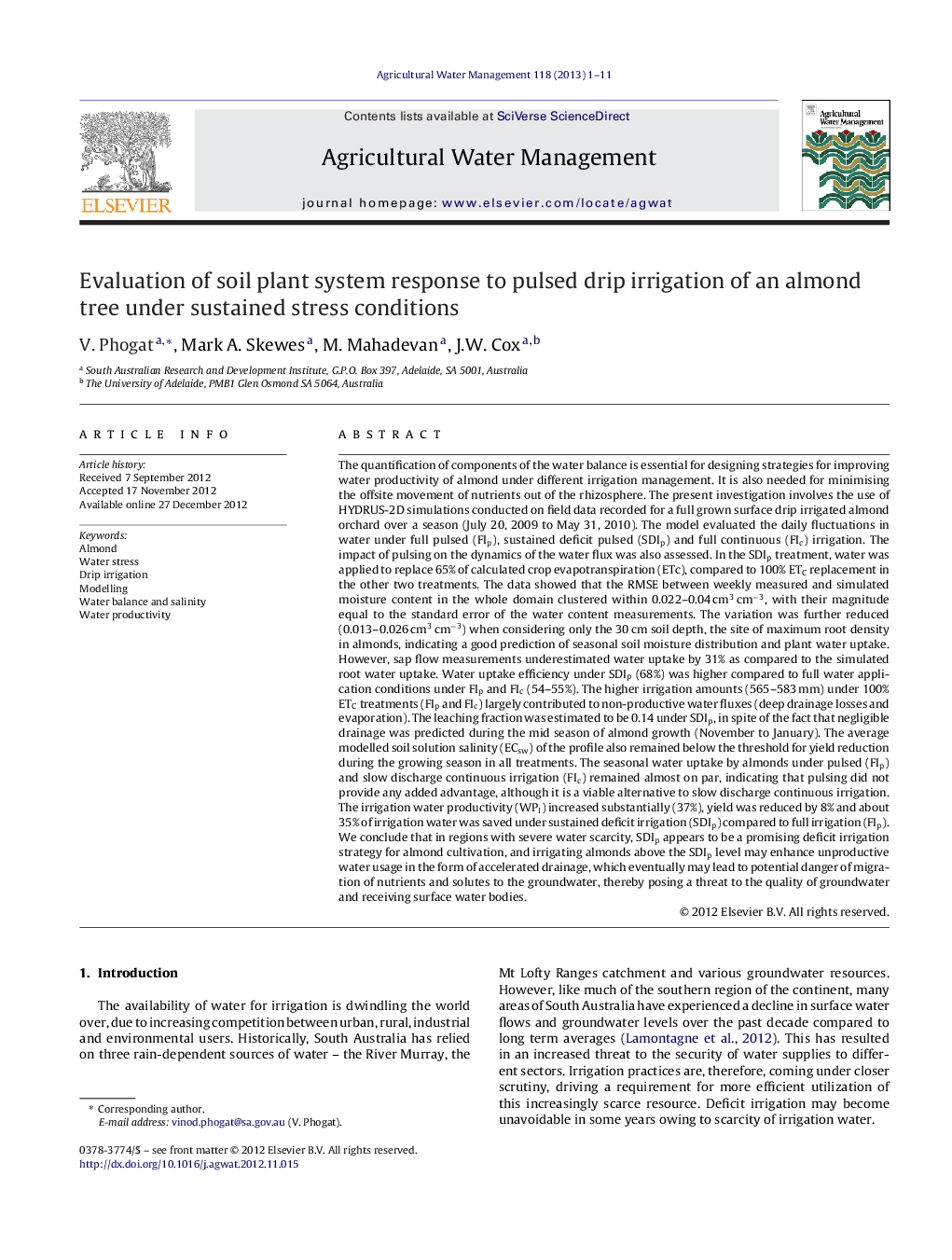| کد مقاله | کد نشریه | سال انتشار | مقاله انگلیسی | نسخه تمام متن |
|---|---|---|---|---|
| 4478939 | 1622961 | 2013 | 11 صفحه PDF | دانلود رایگان |

The quantification of components of the water balance is essential for designing strategies for improving water productivity of almond under different irrigation management. It is also needed for minimising the offsite movement of nutrients out of the rhizosphere. The present investigation involves the use of HYDRUS-2D simulations conducted on field data recorded for a full grown surface drip irrigated almond orchard over a season (July 20, 2009 to May 31, 2010). The model evaluated the daily fluctuations in water under full pulsed (FIp), sustained deficit pulsed (SDIp) and full continuous (FIc) irrigation. The impact of pulsing on the dynamics of the water flux was also assessed. In the SDIp treatment, water was applied to replace 65% of calculated crop evapotranspiration (ETc), compared to 100% ETC replacement in the other two treatments. The data showed that the RMSE between weekly measured and simulated moisture content in the whole domain clustered within 0.022–0.04 cm3 cm−3, with their magnitude equal to the standard error of the water content measurements. The variation was further reduced (0.013–0.026 cm3 cm−3) when considering only the 30 cm soil depth, the site of maximum root density in almonds, indicating a good prediction of seasonal soil moisture distribution and plant water uptake. However, sap flow measurements underestimated water uptake by 31% as compared to the simulated root water uptake. Water uptake efficiency under SDIp (68%) was higher compared to full water application conditions under FIp and FIc (54–55%). The higher irrigation amounts (565–583 mm) under 100% ETC treatments (FIp and FIc) largely contributed to non-productive water fluxes (deep drainage losses and evaporation). The leaching fraction was estimated to be 0.14 under SDIp, in spite of the fact that negligible drainage was predicted during the mid season of almond growth (November to January). The average modelled soil solution salinity (ECsw) of the profile also remained below the threshold for yield reduction during the growing season in all treatments. The seasonal water uptake by almonds under pulsed (FIp) and slow discharge continuous irrigation (FIc) remained almost on par, indicating that pulsing did not provide any added advantage, although it is a viable alternative to slow discharge continuous irrigation. The irrigation water productivity (WPI) increased substantially (37%), yield was reduced by 8% and about 35% of irrigation water was saved under sustained deficit irrigation (SDIp) compared to full irrigation (FIp). We conclude that in regions with severe water scarcity, SDIp appears to be a promising deficit irrigation strategy for almond cultivation, and irrigating almonds above the SDIp level may enhance unproductive water usage in the form of accelerated drainage, which eventually may lead to potential danger of migration of nutrients and solutes to the groundwater, thereby posing a threat to the quality of groundwater and receiving surface water bodies.
► The seasonal water and salinity distribution in soil was very well predicted by HYDRUS-2D.
► Higher irrigation under 100% ETC than deficit treatment (65% ETC) contributed 50% towards drainage.
► Water productivity of almond under deficit irrigation increased by 37% over full irrigation.
► Sap flow underestimated water uptake by 31% as compared to modelled water uptake.
► Irrigation pulsing had little impact on plant water uptake.
Journal: Agricultural Water Management - Volume 118, February 2013, Pages 1–11